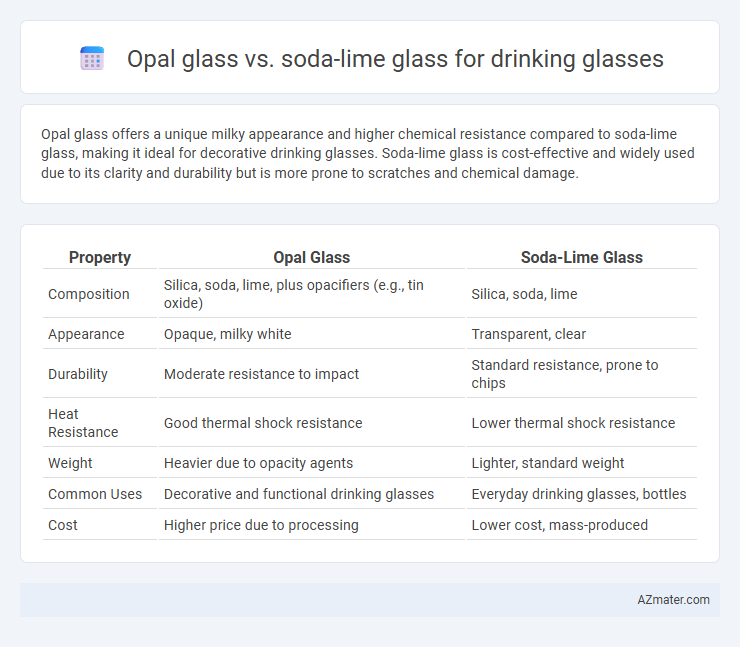Opal glass offers a unique milky appearance and higher chemical resistance compared to soda-lime glass, making it ideal for decorative drinking glasses. Soda-lime glass is cost-effective and widely used due to its clarity and durability but is more prone to scratches and chemical damage.
Table of Comparison
| Property | Opal Glass | Soda-Lime Glass |
|---|---|---|
| Composition | Silica, soda, lime, plus opacifiers (e.g., tin oxide) | Silica, soda, lime |
| Appearance | Opaque, milky white | Transparent, clear |
| Durability | Moderate resistance to impact | Standard resistance, prone to chips |
| Heat Resistance | Good thermal shock resistance | Lower thermal shock resistance |
| Weight | Heavier due to opacity agents | Lighter, standard weight |
| Common Uses | Decorative and functional drinking glasses | Everyday drinking glasses, bottles |
| Cost | Higher price due to processing | Lower cost, mass-produced |
Introduction to Opal Glass and Soda-Lime Glass
Opal glass is a type of glass characterized by its milky, translucent appearance achieved through the addition of opacifiers like tin oxide, making it ideal for decorative and functional drinking glasses with a unique aesthetic. Soda-lime glass, the most common glass type, is composed primarily of silica, soda, and lime, offering durability, clarity, and cost-effectiveness for everyday drinking glassware. While opal glass emphasizes visual appeal and diffused light, soda-lime glass prioritizes transparency and strength, catering to different consumer preferences and uses.
Composition and Manufacturing Processes
Opal glass contains a high percentage of feldspar, quartz, and kaolin with added opacifiers like bone ash or tin oxide, resulting in a milky, translucent appearance, while soda-lime glass primarily consists of silica, soda ash, and limestone, producing a clear, transparent glass. The manufacturing process for opal glass involves controlled cooling and the inclusion of opacifying agents during melting to achieve its characteristic opacity, whereas soda-lime glass is typically produced by melting raw materials at high temperatures followed by rapid cooling to maintain clarity. These compositional and processing differences influence the weight, durability, and aesthetic qualities ideal for drinking glass applications.
Visual Appearance and Aesthetic Differences
Opal glass is characterized by its smooth, milky white, translucent finish that offers a soft, elegant glow, enhancing visual appeal in drinking glasses. Soda-lime glass, in contrast, is typically clear and transparent, providing a classic, crisp look that showcases the contents with clarity and brilliance. The opaque nature of Opal glass contributes to a more refined, vintage aesthetic, while soda-lime glass emphasizes simplicity and modern minimalism.
Durability and Strength Comparison
Opal glass exhibits higher durability and impact resistance compared to soda-lime glass, making it less prone to chipping and breaking during everyday use. Its unique composition, often incorporating borosilicate additives, enhances thermal shock resistance, whereas soda-lime glass tends to be more susceptible to cracks from temperature changes. For drinking glasses requiring long-lasting strength and resilience, opal glass provides superior performance under regular handling and washing conditions.
Thermal Resistance and Temperature Tolerance
Opal glass exhibits superior thermal resistance compared to soda-lime glass, making it more suitable for applications involving sudden temperature changes or hot beverages. Soda-lime glass typically tolerates temperatures up to 150degC, whereas opal glass can withstand higher temperatures around 250degC without cracking or deforming. This enhanced temperature tolerance of opal glass reduces the risk of thermal shock, increasing its durability and safety as a drinking glass material.
Weight and Handling Comfort
Opal glass is denser and heavier than soda-lime glass, providing a sturdier feel but potentially causing fatigue during prolonged use. Soda-lime glass is lighter and more ergonomic, enhancing handling comfort for everyday drinking experiences. Weight differences directly influence user preference, with opal glass offering durability and soda-lime glass prioritizing ease of use.
Safety and Chemical Resistance
Opal glass offers superior safety for drinking glasses due to its non-toxic, lead-free composition and excellent resistance to thermal shock, reducing the risk of cracks or breaks during temperature changes. Soda-lime glass, while cost-effective and widely used, is more prone to chipping and chemical degradation over time when exposed to acidic beverages. Opal glass also maintains high chemical resistance against cleaning agents and acidic drinks, ensuring long-term durability and safety for daily use.
Cost and Availability
Opal glass typically costs more than soda-lime glass due to its specialized manufacturing process and aesthetic appeal, making it less common in the mass market. Soda-lime glass is widely available and more affordable, produced in large quantities for everyday drinking glasses with consistent durability. Choosing between the two depends largely on budget constraints and the desired visual effect, with soda-lime glass being the economic choice for volume purchases.
Environmental Impact and Recyclability
Opal glass, often made from borosilicate or other specialized formulations, has a higher environmental impact due to more energy-intensive production processes compared to soda-lime glass, which is the most common and energy-efficient type of glass used for drinking glasses. Soda-lime glass boasts superior recyclability, being widely accepted in recycling programs and can be reprocessed repeatedly without loss of quality, while opal glass recycling is limited and less efficient because of its unique composition. Choosing soda-lime glass minimizes carbon footprint and supports circular economy efforts in the glass industry.
Choosing the Right Glass for Everyday Use
Opal glass offers superior durability and scratch resistance compared to soda-lime glass, making it ideal for everyday drinking glasses that require longevity and ease of maintenance. Soda-lime glass, while more affordable and widely available, is more prone to chipping and breakage under frequent use, which can impact its suitability for daily handling. Choosing opal glass ensures a combination of aesthetic appeal and functional resilience, providing a safer and more reliable experience for regular drinking purposes.

Infographic: Opal glass vs Soda-lime glass for Drinking glass
 azmater.com
azmater.com